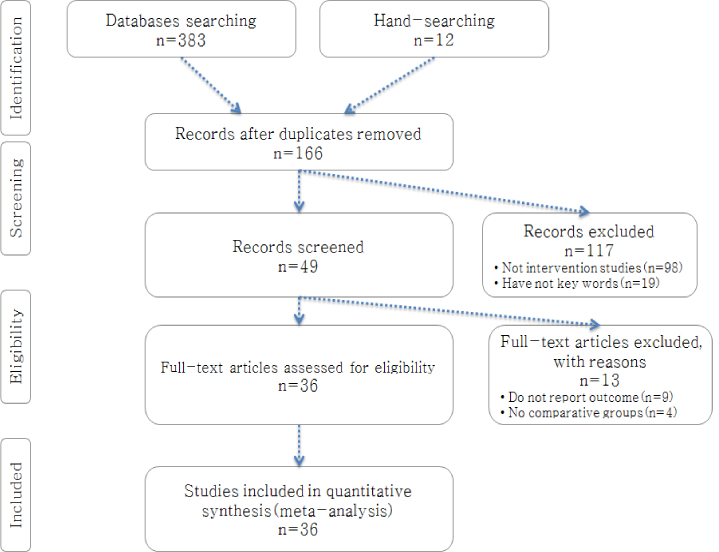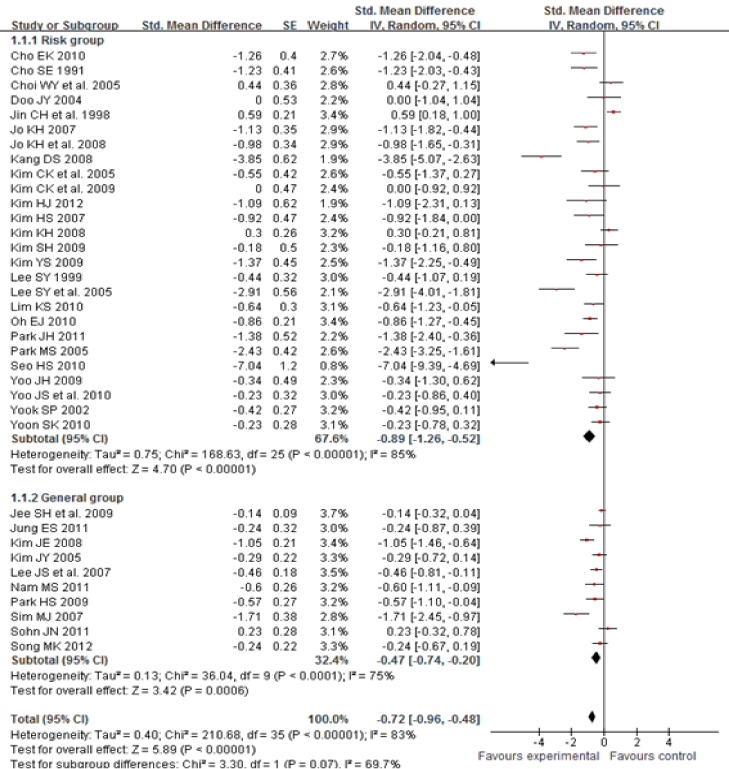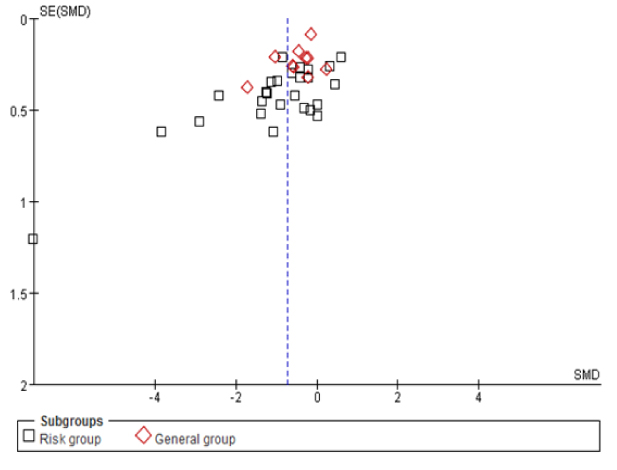J Korean Acad Psychiatr Ment Health Nurs.
2013 Dec;22(4):273-284.
Efficient Suicide Prevention Intervention: Meta-Analysis
- Affiliations
-
- 1Department of Nursing, Busan Womens College, Busan, Korea.
- 2Department of Nursing, Inje University, Busan, Korea. jibai@inje.ac.kr
- 3Institute for Health Research, Inje University, Busan, Korea.
- 4International Safe Community Research Center of Busan Metropolitan, Busan, Korea. jibai@inje.ac.kr
Abstract
- PURPOSE
The purpose of this study was to evaluate the suicide ideation effects of suicide prevention program.
METHODS
Using several databases, studies were collected from March, 2012 to August, 2012. For the purpose of a systematic literature review, in this study analysis was done of pretested-posttested research among non-randomized studies utilizing suicide prevention program, and having set the intervention as the independent variable suicidal idea as a dependent variable.
RESULTS
The result of interventions on suicide prevention showed a moderate effect at -0.72 (96% CI: -0.96, 0.48). For intervention types, reality therapy was most effective overall, while the life cycle was found to be most effective for young people (d=-1.57, 95% CI: -2.70, -0.43). The periods for the intervention on suicide prevention was shown to be most effective when it was repeated over 20 times (d=-1.55, 95% CI:-2.75, -0.35), and also it worked better for the risk group than a general group (d=-0.89, 95% CI: -1.26, 0.52).
CONCLUSION
The findings of this study support basic data for interventions to prevent future suicide and the need for further development of prevention programs.
Keyword
MeSH Terms
Figure
Reference
-
1. Chan SS, Leung VP, Tsoh J, Li SW, Yu CS, Yu GK, et al. Outcomes of a two-tiered multifaceted elderly suicide prevention program in a Hong Kong chinese community. Am J Geriatr Psychiatry. 2011; 19:185–196.
Article2. Conwell Y. Suicide in later life: a review and recommendation for prevention. Suicide Life Threat Behav. 2001; 31:Suppl. 32–47.3. Corcoran J, Dattalo P, Crowley M, Brown E, Grindle L. A systematic review of psychosocial interventions for suicidal adolescents. Child Youth Serv Rev. 2011; 33:2112–2118.
Article4. Crosby AE, Han B, Ortega AG, Parks SE, Gfroerer J. Suicidal thoughts and behaviors among adults aged ≥18 years--United States, 2008-2009. MMWR Surveill Summ. 2011; 60(13):1–22.5. De Leo D, Scocco P. Treatment and prevention of suicidal behavior in the elderly. In : Hawton K, van Heeringen K, editors. The international handbook of suicide and attempted suicide. NJ: John Wiley & Song. Ltd;2000. p. 555–570.6. Fairweather AK, Anstey KJ, Rodgers B, Butterworth P. Factors distinguishing suicide attempters from suicide ideation in a community sample: Social issues and physicalhealth problems. Psychol Med. 2006; 36:1235–1245.
Article7. Glass GV. Meta-analysis: An approach to the synthesis of research results. J Res Sci Teach. 1982; 19:93–112.
Article8. Health & Welfare Committee. Law for suicide prevention and the composition of life-respect culture. Seoul: Author;2011.9. Hedges H, Olkin I. Statistical methods for meta-analysis. Orlando, FL: Academic Press;1985.10. Hooven C, Herting JR, Snedker KA. Long-term outcomes for the promoting CARE suicide prevention program. Am J Health Behav. 2010; 34:721–736.
Article11. James RK, Gilliland BE. Crisis intervention strategies. 4th ed. Singapore: Thomson;2001.12. Kim JI, Yoon HS, Han SO. Effects of the program improving adjustment to military life, on stress, depression, idea of suicide, self-esteem, and adjustment to military living in auxiliary police. J Korean Acad Fundam Nurs. 2008; 15:387–394.13. Kim MS. Meta-analysis for intervention effect of suicide prevention program. Korean J Soc Welf Res. 2012; 30:27–56.14. Kim YS. The effect of a group counseling program on depression and suicidal prevention in high school students. J Korean Acad Community Health Nurs. 2009; 20:343–350.15. Korea Institute for Health and Social Affairs. Policy issues and directions for a rapid increase in suicides in Korea. Seoul: Author;2012.16. Lee SY, Choi WG, Kim CK. Effectiveness of a reality therapy-based group counseling program on the reduction of adolescent depression and suicidal ideation. Korean J Youth Stud. 2005; 12:141–186.17. Lester D. Psychotherapy for suicidal clients. Death Stud. 1994; 18:361–374.
Article18. Lim KS, Kim HS. Effect of life respect programs for the elderly on depression and suicidal ideation of elderly. J Welf Aged. 2012; 55:201–222.19. Maltsberger JT. The prevention of suicide in adults. In : Leenaars AA, editor. Life span perspectives of suicide. New York: Plenum Press;1991. p. 295–307.20. Maris RW. Pathways to suicide: A survey of self-destructive behaviors. Baltimore: Jones Horkins University Press;1981.21. Ministry of Health & Welfare. OECD Health Data 2011. Seoul: Author;2012.22. Moon DK. A meta-regression analysis on related variables of adolescents' suicidal ideation. Cheongju: Chungbuk National University;2011. Unpublished doctoral dissertation.23. Ougrin D, Latif S. Specific psychological treatment versus treatment as usual in adolescents with self-harm: Systematic review and meta-analysis. Crisis. 2011; 32:74–80.
Article24. Robinson J, Hetrick SE, Martin C. Preventing suicide in young people: Systematic review. Aust N Z J Psychiatry. 2011; 45:3–26.
Article25. Rosenthal R. Meta-analytic procedures for social research. Newbury Park, CA: Sage Publications;1991.26. Scottish Intercollegiate Guideline Network (SIGN). SIGN 50: A guideline developer's handbook. Edinburgh: Author;2012. 01.27. Shirk SR, Gudmundsen G, Kaplinski HC, McMakin DL. Alliance and outcome in cognitive-behavioral therapy for adolescent depression. J Clin Child Adolesc Psychol. 2008; 37:631–639.
Article28. Sohn JN. The effects of the peer suicide prevention gatekeeper program for middle school students. J Korean Acad Psychiatr Ment Health Nurs. 2011; 20:111–119.
Article29. Stein BD, Kataoka SH, Hamilton AB, Schultz D, Ryan G, Vona P, et al. School personnel perspectives on their school's implementation of a school-based suicide prevention program. J Behav Health Serv Res. 2009; 37:338–349.
Article30. Tarrier N, Taylor K, Gooding P. Cognitive-behavioral interventions to reduce suicide behavior-A systematic review and meta-analysis. Behav Modif. 2008; 01. 32:77–108.
Article
- Full Text Links
- Actions
-
Cited
- CITED
-
- Close
- Share
- Similar articles
-
- Development and Application of a Multidimensional Suicide Prevention Program for Korean Elders by utilizing a Community Network
- Effects of a Nurse Presence Program on Suicide Prevention for Elders with a Chronic Disease
- The Effect of Korean Standardized Suicide Prevention Program on Intervention by Gatekeepers
- Medical policy for suicide prevention
- How Should We Approach Nurse Suicide in Korea: With the Aspect of Prevention-InterventionPostvention Management




